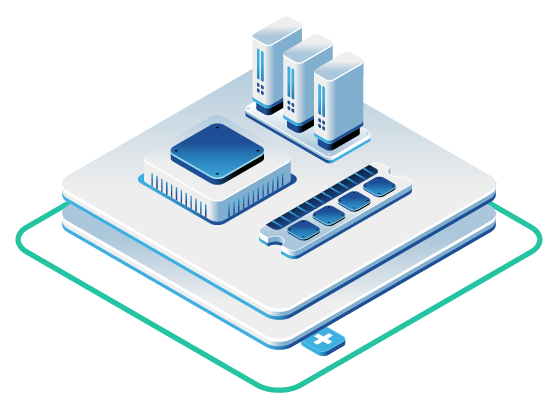In this article
- Why Apache Spark and Hadoop Together Create Big Data Success
- Foundation: Building Your OpenMetal Infrastructure
- Deployment Strategy: Architecting for Performance
- Storage Architecture: Local vs. Distributed Approaches
- Network Optimization: Maximizing Internal Traffic Performance
- System-Level Performance Tuning
- Application-Level Optimization Strategies
- Real-World Implementation Examples
- Monitoring and Maintenance Best Practices
- Cost Optimization and Scaling Strategies
- Next Steps: Getting Started with OpenMetal
The modern data landscape demands processing frameworks that can handle massive datasets while delivering insights at the speed of business. Apache Spark and Hadoop have emerged as the backbone technologies for big data processing, offering complementary capabilities that, when properly deployed and optimized, create a formidable data processing platform. This comprehensive guide explores proven strategies for deploying and optimizing these technologies on OpenMetal’s bare metal infrastructure to maximize performance and minimize costs.
Why Apache Spark and Hadoop Together Create Big Data Success
The combination of Apache Spark and Hadoop represents a powerful synergy in big data processing. While Hadoop provides distributed storage (HDFS) and processing power (MapReduce and YARN) for large datasets, Spark adds significant value through its in-memory processing capabilities for real-time data analysis.
Spark is intended to enhance, not replace, the Hadoop stack. From day one, Spark was designed to read and write data from and to HDFS, as well as other storage systems. This complementary relationship allows organizations to leverage the reliability and scale of Hadoop’s storage while benefiting from Spark’s superior processing speed.
The performance advantages are substantial. With capabilities like in-memory data storage and near real-time processing, the performance can be several times faster than other big data technologies. For iterative workloads common in machine learning and analytics, Spark can accelerate Hive queries by as much as 100x when the input data fits into memory, and up 10x when the input data is stored on disk.
Key integration benefits include:
- Enhanced Processing Speed: Spark’s in-memory processing speeds up data computation while Hadoop provides reliable distributed storage
- Resource Efficiency: Running Spark on Hadoop YARN allows both frameworks to share resources efficiently within the same cluster
- Fault Tolerance: Both systems provide built-in resilience through automatic recovery and data replication
- Ecosystem Integration: Seamless compatibility with tools like Hive, HBase, and Kafka for comprehensive data pipelines
Foundation: Building Your OpenMetal Infrastructure
A successful deployment on OpenMetal starts with taking advantage of our cloud automation and unique network architecture. The platform’s Cloud Core of three bare metal servers can be provisioned in under a minute, providing the foundation for your big data cluster.
Initial Infrastructure Setup
The first step in your deployment plan should be to create a dedicated private network for all internal cluster communication. Routing all HDFS replication and Spark shuffle traffic over this network fully utilizes the platform’s free internal traffic on 20 Gbps NICs, isolating your workload for the best performance and removing the data transfer costs of public clouds.
This network configuration is particularly important for Spark and Hadoop clusters because:
- Data Locality: HDFS block replication and Spark’s shuffle operations generate significant internal traffic
- Performance Isolation: Dedicated networks prevent interference from other workloads
- Cost Control: Internal traffic on OpenMetal doesn’t incur transfer charges, unlike public cloud providers
Hardware Selection for Optimal Performance
OpenMetal gives you access to top-of-the-line hardware, including strong Intel Xeon processors, lots of RAM (DDR4/DDR5), and very fast NVMe SSD storage (like Micron 7450 MAX). This speed is essential for tasks that read and write a lot of data, common in processing (Spark, Flink), querying (Trino, Presto), and the transaction parts of lakehouse formats.
Choose servers based on your workload characteristics:
- Memory-Intensive Workloads: Select configurations with high RAM-to-CPU ratios for Spark caching
- Storage-Intensive Operations: Prioritize NVMe storage capacity for local data processing
- Network-Bound Applications: Ensure adequate network bandwidth for distributed operations
Deployment Strategy: Architecting for Performance
Deployment Methods and Architecture Patterns
There are multiple methods for integrating Spark with Hadoop infrastructure:
- Standalone Mode: Spark runs independently and pulls data from HDFS, leveraging Hadoop’s storage without depending on Hadoop’s processing
- YARN Mode: Spark and Hadoop run side-by-side on YARN, sharing resources in the same environment
- SIMR (Spark in MapReduce): For environments without YARN, SIMR allows Spark jobs to be embedded within MapReduce
For most production deployments on OpenMetal, YARN Mode provides the best balance of resource utilization and operational simplicity. This approach allows you to run multiple processing engines while maintaining centralized resource management.
Cluster Topology Design
Design your cluster topology to match your data processing patterns:
Master Node Configuration:
- Deploy YARN ResourceManager, HDFS NameNode, and Spark History Server
- Use dedicated nodes with sufficient memory for metadata operations
- Implement high availability with secondary NameNodes
Worker Node Optimization:
- Co-locate HDFS DataNodes with YARN NodeManagers
- Configure Spark executors to align with physical CPU cores
- Balance memory allocation between HDFS caching and Spark operations
Storage Architecture: Local vs. Distributed Approaches
Once the core infrastructure is ready, you should decide how to architect the data layer. Your choice between local and distributed storage significantly impacts both performance and operational complexity.
Option 1: Local NVMe Storage for Maximum Performance
For maximum I/O performance, you can configure Hadoop HDFS to run directly on the local NVMe drives of each worker node, co-locating storage and compute for the lowest possible latency. This approach offers several advantages:
- Ultra-Low Latency: Direct access to local storage eliminates network overhead
- Predictable Performance: No competition for storage bandwidth from other tenants
- Cost Efficiency: Maximum utilization of provisioned storage capacity
Implementation considerations:
- Configure HDFS to use local NVMe drives as DataNode storage
- Set replication factor to 3 for fault tolerance across nodes
- Use short-circuit reads to bypass the network stack for local data access
Option 2: Distributed Storage with Ceph Integration
Alternatively, for better flexibility and independent scaling, you can use the underlying Ceph storage platform through its S3-compatible RADOS Gateway. This modern, decoupled approach is great for creating a persistent data lake that can be accessed by multiple, ephemeral Spark clusters without needing to move data.
OpenMetal provides private Ceph storage clusters that have key attributes needed by Delta Lake, including compression on the fly of up to 15:1 on text and similar file types, dramatically reducing used storage capacity. The entire ecosystem of modern data tools, including Apache Spark and Delta Lake, is built to communicate natively with this S3 interface.
Benefits of the Ceph approach:
- Independent Scaling: Scale storage and compute resources separately
- Multi-Cluster Access: Multiple Spark clusters can access the same data simultaneously
- Persistent Storage: Data survives cluster termination and recreation
- Advanced Features: Built-in compression, erasure coding, and multi-site replication
Network Optimization: Maximizing Internal Traffic Performance
OpenMetal’s hardware and capabilities support this type of big data workload well. The fast 20 Gbps network makes sure that our powerful bare metal servers can always talk to each other without getting bogged down. This allows big systems like Spark and Hadoop to run as one unified, high-speed cluster.
Network Configuration Best Practices
- Dedicated VLANs: Create separate VLANs for management, data replication, and client traffic
- Traffic Prioritization: Configure Quality of Service (QoS) rules to prioritize HDFS and Spark shuffle traffic
- Network Topology Awareness: Configure Hadoop rack awareness to optimize data placement
Optimizing for Spark Shuffle Operations
Spark shuffle operations can become network bottlenecks in large clusters. Optimize these patterns by:
- Configuring appropriate partition counts to balance parallelism and overhead
- Using efficient serialization formats like Kryo
- Tuning shuffle service parameters for your workload characteristics
System-Level Performance Tuning
The advantages of OpenMetal become clear during optimization, where full root access to bare metal opens up performance advantages that aren’t possible on virtualized clouds. You can directly tune the Linux kernel, set the CPU governor to performance mode to lock in maximum clock speeds, and change the I/O scheduler to noop to reduce overhead on the NVMe drives.
Operating System Optimizations
CPU Governor Configuration:
# Set CPU governor to performance mode
echo performance | sudo tee /sys/devices/system/cpu/cpu*/cpufreq/scaling_governor
I/O Scheduler Optimization:
# Set I/O scheduler to noop for NVMe drives
echo noop | sudo tee /sys/block/nvme*/queue/scheduler
Memory Management Tuning:
# Optimize for big data workloads
echo 'vm.swappiness=1' >> /etc/sysctl.conf
echo 'vm.dirty_ratio=15' >> /etc/sysctl.conf
echo 'vm.dirty_background_ratio=5' >> /etc/sysctl.conf
Kernel Parameter Optimization
Configure kernel parameters specifically for big data workloads:
# Network buffer optimization
echo 'net.core.rmem_max = 134217728' >> /etc/sysctl.conf
echo 'net.core.wmem_max = 134217728' >> /etc/sysctl.conf
echo 'net.ipv4.tcp_rmem = 4096 65536 134217728' >> /etc/sysctl.conf
echo 'net.ipv4.tcp_wmem = 4096 65536 134217728' >> /etc/sysctl.conf
# File descriptor limits
echo '* soft nofile 1048576' >> /etc/security/limits.conf
echo '* hard nofile 1048576' >> /etc/security/limits.conf
Application-Level Optimization Strategies
This level of control also extends to the application layer, where you can precisely configure Spark executor cores and memory to match the physical hardware. This ensures near 100% resource utilization and gets the maximum possible performance from your big data cluster.
Spark Configuration Optimization
Executor Sizing Strategy: Calculate optimal executor configuration based on your hardware:
# For a 32-core, 128GB RAM server
spark.executor.instances=4
spark.executor.cores=7
spark.executor.memory=24g
spark.executor.memoryFraction=0.8
Memory Management Tuning:
# Optimize memory allocation
spark.sql.adaptive.enabled=true
spark.sql.adaptive.coalescePartitions.enabled=true
spark.serializer=org.apache.spark.serializer.KryoSerializer
spark.sql.adaptive.advisoryPartitionSizeInBytes=128MB
Hadoop Configuration Optimization
HDFS Tuning Parameters:
<!-- dfs.block.size optimized for large files -->
<property>
<name>dfs.block.size</name>
<value>268435456</value>
</property>
<!-- Increase replication thread count -->
<property>
<name>dfs.namenode.replication.max-streams</name>
<value>10</value>
</property>
YARN Resource Configuration:
<!-- Configure memory allocation -->
<property>
<name>yarn.nodemanager.resource.memory-mb</name>
<value>102400</value>
</property>
<property>
<name>yarn.scheduler.maximum-allocation-mb</name>
<value>102400</value>
</property>
Real-World Implementation Examples
Industry Applications of Spark and Hadoop Integration
Based on documented use cases, several industries have successfully leveraged Spark and Hadoop integration for specific applications:
Financial Services Applications: Spark and HBase integration is widely used for fraud detection and real-time transaction analysis. The combination provides the speed needed for real-time decision making while maintaining the reliability required for financial data processing.
Retail and E-commerce Use Cases: Apache Spark for Hadoop efficiency integration helps e-commerce platforms process large datasets, including browsing history and purchase patterns. This enables personalized recommendations and customer analytics at scale.
Telecommunications Industry: Companies leverage Spark and HBase to handle call data records and monitor network performance. With millions of records generated every minute, Spark’s in-memory processing allows quick analysis of call details.
Healthcare Analytics: In the healthcare industry, Spark and HBase power real-time patient monitoring systems and predictive analytics for healthcare providers.
Technical Implementation Patterns
Streaming Data Architecture: Integration of Spark with streaming tools like Flume and Apache Kafka smoothens the process of real-time data ingestion. Spark Streaming processes data in real-time as it flows in from sources like Kafka, allowing immediate analysis.
Storage and Processing Integration: OpenMetal customers have successfully implemented architectures where data ingested can be consumed by Apache Spark for real-time ETL, stored in a Delta Lake format on a distributed Ceph object storage cluster, and ultimately made available for analytics and machine learning applications.
Monitoring and Maintenance Best Practices
Continuous monitoring and proactive maintenance ensure your Spark and Hadoop clusters maintain optimal performance as they scale.
Performance Monitoring Strategy
Key Metrics to Track:
- Cluster resource utilization (CPU, memory, disk, network)
- Application-level metrics (job execution time, data throughput)
- System health indicators (node availability, service status)
Monitoring Stack Implementation:
# Deploy monitoring infrastructure
# Prometheus for metrics collection
# Grafana for visualization
# ELK stack for log aggregation
Automated Maintenance Procedures
Daily Operations:
- HDFS health checks and block replication verification
- Spark application log analysis and cleanup
- Resource utilization trend analysis
Weekly Maintenance:
- HDFS balancer execution for optimal data distribution
- Spark history server cleanup and archival
- Performance baseline updates and trend analysis
Cost Optimization and Scaling Strategies
The end goal of processing data is to deliver the results and our generous egress allowance lets customers send terabytes of that finished work to users without getting hit with huge, surprise transfer fees. Our expert team is also ready to help with everything from the initial setup to the deep-level tuning needed to make sure you get every bit of performance out of your hardware.
Scaling Approaches
Horizontal Scaling:
- Add worker nodes during peak processing periods
- Implement auto-scaling based on queue depth and resource utilization
- Use spot instances for non-critical batch workloads
Vertical Scaling:
- Upgrade individual nodes with more memory or faster storage
- Optimize resource allocation across existing hardware
- Implement workload-specific node configurations
Cost Optimization Techniques
Resource Right-Sizing:
- Monitor actual resource consumption patterns
- Adjust cluster sizing based on utilization trends
- Implement time-based scaling for predictable workloads
Storage Cost Management:
- Implement data lifecycle policies for automatic archival
- Use compression and deduplication features in Ceph
- Optimize replication factors based on data criticality
Next Steps: Getting Started with OpenMetal
Our experience in building and deploying high-performance big data workloads means we can get customers going much faster, saving time and money. Whether you’re planning a new deployment or optimizing an existing cluster, OpenMetal provides the infrastructure foundation and expertise needed for success.
Getting Started Checklist
- Infrastructure Assessment:
- Evaluate your current data processing requirements
- Determine optimal hardware configurations
- Plan network topology and security requirements
- Deployment Planning:
- Choose storage architecture (local vs. distributed)
- Design cluster topology and scaling strategy
- Implement monitoring and alerting systems
- Performance Optimization:
- Apply system-level tuning recommendations
- Configure application parameters for your workloads
- Establish performance baselines and monitoring
- Operational Excellence:
- Implement automated maintenance procedures
- Establish disaster recovery and backup strategies
- Plan for capacity growth and scaling
Expert Support and Services
OpenMetal’s team brings deep expertise in Spark and Hadoop deployments, offering:
- Architecture Consulting: Design optimal cluster configurations for your specific use cases
- Performance Tuning: Apply advanced optimization techniques for maximum throughput
- Operational Support: Ongoing monitoring, maintenance, and troubleshooting assistance
- Migration Services: Seamless transition from existing infrastructure or cloud providers
By leveraging OpenMetal’s bare metal infrastructure and expert guidance, you can build Spark and Hadoop clusters that deliver exceptional performance while maintaining cost efficiency and operational simplicity. The combination of dedicated hardware, network performance, and specialized expertise creates the ideal foundation for your big data processing needs.
Whether you’re processing petabytes of historical data, running real-time analytics, or training machine learning models, the strategies outlined in this guide will help you maximize the value of your Apache Spark and Hadoop investment on OpenMetal’s platform.
Ready to optimize your big data workloads? Contact OpenMetal’s experts to discuss your Spark and Hadoop deployment requirements and discover how our bare metal infrastructure can accelerate your data processing capabilities.
Schedule a Consultation
Get a deeper assessment and discuss your unique requirements.
Read More on the OpenMetal Blog


































